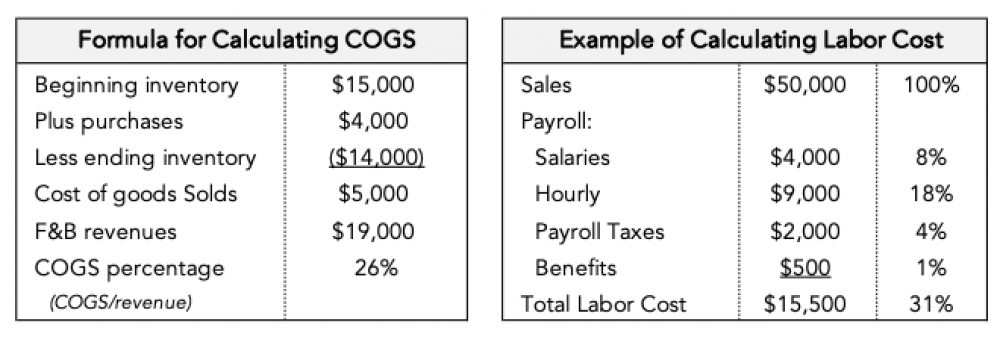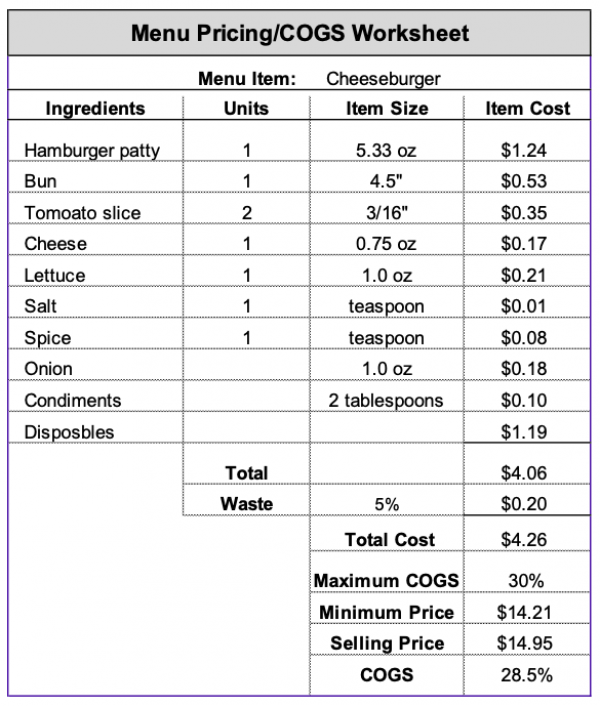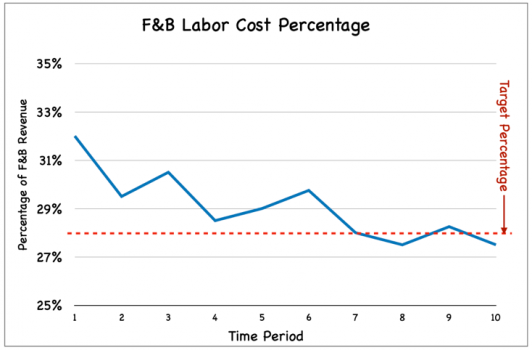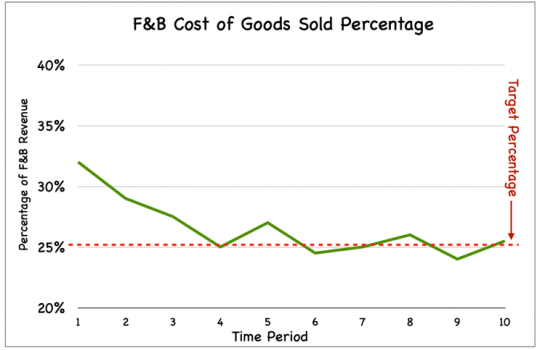
Vol. I, No. 4, June 2023
Managing key performance indicators for profitable food and beverage
Food and beverage sales are essential to offering visitors an enjoyable and memorable agritourism experience that they'll want to repeat. An agritourism facility with well-crafted and executed food and beverage (F&B) can increase its market appeal and increase other sales by extending the guests' length-of-stay. F&B can drive visits - come for the food and stay for the fun. As crucial as F&B is to the visitor experience equation, profitability is just as important.
Successful F&B operations requires monitoring specific key performance indicators (KPIs) which help a business benchmark its financial and operational performance for continuous improvement and growth.
One F&B KPI that should be monitored daily is per capita F&B sales . This gives much more meaningful data than just monitoring gross F&B revenues. Agritourism festival events have the potential to achieve per capita F&B sales of $15 or greater. The goal is to increase per capita F&B sales and to immediately identify any problems that might be suppressing them.
Another F&B KPI is prime cost. F&B sales can add $6 or more in profit for every visitor with adequately managed prime costs.
Prime cost is the total cost of goods sold - food, beverage, and related paper products such as disposable cups, napkins, etc. - ( COGS) plus the gross labor cost for all F&B employees. Labor cost includes payroll, taxes, worker's comp, medical insurance, and other employee benefits. In the restaurant industry, the prime cost benchmark is 60%, typically 30% for labor and 30% for COGS. Although the labor and COGS percentages may vary, they should not exceed a total of 60%. Agritourism festivals typically offer a lot of high-margin, highly profitable foods such as kettle corn, donuts, and funnel cakes. For agritourism festivals, a good benchmark for prime cost is 55% or less (the total cost of food, beverage, associated paper goods, and all labor costs should not exceed 55%.)
It is essential to track prime cost regularly, as it includes the two controllable costs - labor and cost of goods sold. However, we often find that agritourism operators:
- Don't track labor costs separately for F&B, but rather lump all labor together for their entire facility, or
- Track labor as a percentage of F&B sales only on a monthly or less frequent basis, or
- Rarely track F&B COGS except on an annual basis.
The problem with such infrequent tracking of prime cost is that considerable time, perhaps the entire season, can have passed before the operator recognizes that costs may have exceeded the benchmark. There's no way to go back and correct costs at that point, so it represents a permanently lost profit opportunity. For example, maybe the costs of some raw products have increased and driven up food costs. If you wait for several weeks to find out, you've lost the opportunity to adjust menu prices or find less expensive substitutes. Perhaps some new employees haven't been adequately trained and aren't following proper portion control. Maybe staff is being inefficiently scheduled. Waiting a month or longer to determine that labor costs are 40% instead of 25% means your costs have been higher than necessary. Or perhaps an employee has been stealing some food product from your walk-in regularly or giving food away free to friends visiting the farm (yes, this happens much more frequently than most operators imagine). Waiting months to calculate COGS to finally learn things are out of kilter can mean you let thousands of dollars of F&B walk out the back door (literally) or not get paid for it.
Regarding labor costs, we recommend that its percentage of F&B revenue be calculated daily. Yes, that's right, daily! It isn't hard to set up your accounting system to do this. Each morning, the F&B manager gets a report on what the labor percentage was for the previous day. That allows the F&B manager to learn how to improve through immediate feedback. If you wait weeks or months to give them this information, they will have forgotten what they did on particular days regarding scheduling, causing the high labor cost. If they get a report the next morning, however, they can reflect on the previous day and perhaps learn what can be done differently to improve the labor percentage in the future.
The other advantage of daily reporting is that it sends a loud and clear message to your F&B manager that controlling labor costs is essential. The adage, "That which gets measured gets attention," is very true. Labor is your most controllable cost, so it only makes sense to set up a reporting system that helps your managers stay focused on controlling it.
Calculating the COGS part of prime cost also needs to be done frequently. Most chain restaurants do it weekly. At a minimum, it should be done bi-weekly. Weekly or bi-weekly cost reporting will change the attitudes and behavior of your kitchen staff, as it creates awareness of the importance of controlling F&B costs. It also lets employees know they are being held accountable. If there is a problem, you will learn about it quickly and can respond accordingly. Regular food costing will easily result in a three percentage point or greater reduction in COGS. Again, that which gets measured gets attention.
Calculating COGS requires a physical inventory of all F&B supplies on hand and a calculation of their costs. This takes some time, but with a well-organized stockroom and by setting up simple inventory worksheets, a physical inventory can quickly be done in an hour or so. Conducting regular physical inventories also requires the discipline of setting a fixed scheduled time for it every week or every other week.
The following charts show the examples for calculating overall COGS and labor percentage

When auditing the operations of many of our agritourism clients, we often discover their menu prices have not been appropriately calculated to produce desired profit margins. That is an important KPI to monitor. We frequently find COGS running 40%, 50%, or greater on their F&B sales due to not pricing menu items correctly or not monitoring the menu item COGS and adjusting prices when foods cost go up.
There appears to be a tendency with farmers, perhaps due to their good nature, to underprice menu items for fear that too high a price will hurt sales or that they will be taking unfair advantage of guests. We often find that clients have priced their menu items under the market for similar quality restaurant offerings, sometimes for even less than McDonald's sells those items. You should never price your menu items for less than comparable restaurant prices based on the quality of what you are offering. You are not competing with McDonald's as you have a captive customer. But you don't want to price too high like theme parks where visitors will feel ripped off. Menu prices that are too low can hurt sales, as visitors will be suspicious that the food is low quality based on the price. You can command a premium price over comparable restaurant operations with good quality products and display cooking, such as grilling foods such as corn right in front of customers. The public sees it as more of a value equation than an absolute price consideration when purchasing quality prepared foods.

Properly setting menu prices requires a detailed cost analysis of each menu item, ensuring the cost includes every ingredient and disposable paper/plastic item used. For example, the cost analysis for a cheeseburger should include the hamburger, cheese, roll, lettuce, tomato, onion, seasoning, condiments, and disposables - paper plates, napkins, etc. Then a factor needs to be added for waste - food that spoils, dropped food that is thrown away, and prepared leftover food that can't be saved at the end of the day. Then, you divide the menu item's total cost by your desired maximum COGS. In the example shown, you want to maintain a COGS not to exceed 30%. To calculate the minimum selling price, divide the total cost of $4.26 by 30% to get the target-selling price of $14.21. But don't stop there. If cheeseburgers of that quality are selling in the $15 range in your market, set the price higher at $14.95, which gives you a 28.5% COGS. Also, regardless of comparable selling prices, you should always increase the price to some normal menu price, such as $14.89 or $14.95, which is not perceived as really different than $14.21.
In addition to supplying labor costs and COGS to your F&B manager, taking an open-bookapproach of sharing this information with all F&B staff greatly improves performance. We advise our clients to post two graphs where the F&B staff will see them daily. One can show the weekly labor percentage and the other the weekly or bi-weekly COGS. The vertical y-axis should show ascending percentage, and the horizontal x-axis should indicate the time periods. The target range should also be shown. Then, each day or week, the new results are posted. This gives the staff immediate feedback. If the percentage is in the target range, that is good. If the graph shows costs going up, that tells employees things are moving in the wrong direction (increasing percentage). If the percentage on the graph is going down, that means the staff is improving.


The open-book approach conveys to all F&B staff members that controlling prime cost is essential. It gives them immediate feedback on how they are performing. Staff members have far more control of COGS than anyone else because they handle portion control. They create waste. They are doing (or not doing) the up-selling to more profitable food items. The graphs will help them understand why proper portion control, minimizing waste, and up-selling are important. It lets the F&B staffers know they're regularly evaluated in these performance areas. It also lets them know that their theft will quickly show up in the performance results if they steal. And if their hours need to be cut back, they can better understand why -- that it is necessary from a business profitability standpoint and is not some arbitrary management decision.
Controlling the key performance indicators for prime cost requires procedures and discipline. When done correctly, you will have a continuous stream of profits from your food and beverage sales.
Subscribe to Agritourism Today



